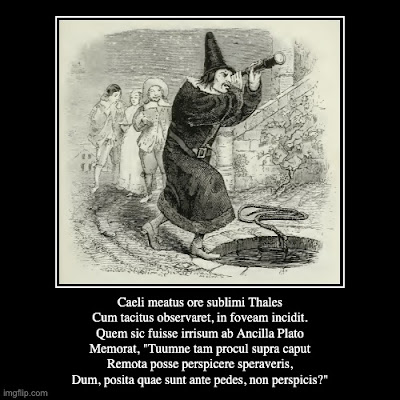This project has moved to a blog of its own: Fabulae Aesopi.
I'm excietd that I get to finish this series of posts about the Latin verse fables of Desbillons with one of my favorite fables (for more about Desbillons, see the starting post). We've reached Book 15 (see bottom of post for all the fables in the book), and the one I'm focusing on is the story of the philosopher in the ditch.
15.45 Thales et Ancilla
Caeli meatus ore sublimi Thales
Cum tacitus observaret, in foveam incidit.
Quem sic fuisse irrisum ab Ancilla Plato
Memorat, "Tuumne tam procul supra caput
Remota posse perspicere speraveris,
Dum, posita quae sunt ante pedes, non perspicis?"
Here is the poem written out in English prose order to help in reading:
Cum Thales,
tacitus,
ore sublimi
observaret
caeli meatus,
incidit in foveam.
Plato memorat
[Thalem]
quem sic fuisse irrisum ab Ancilla,
"Speraverisne posse perspicere remota
tam procul supra tuum caput,
dum non perspicis
quae sunt posita ante pedes?"
Plato gets a mention here because he reported this story in his Theaetetus, and as a result of this philosophical fame, the story has its own Wikipedia article: The Astrologer who Fell into a Well. The fable is Perry 40 in the Aesopic canon.
The meter is iambic, and here is some help with the meter (for more about iambic meter, see the post about Desbillons 1.1).
Caeli · mea · tus o · re sub · limi · Thales
Cum taci · tus ob · serva · ret, in · fove~ in · cidit.
Quem sic · fuis · s~ irris~ · ab An · cilla · Plato
Memorat · "Tuum · ne tam · procul · supra · caput
Remo · ta pos · se per · spicere · spera · veris,
Dum, posi · ta quae · sunt an · te pedes · non per · spicis?
You can find illustrations for the fable here. Here's one by Grandville, and I used imgflip to make it a graphic:
1. acanthis et pueri (lines: 20+)
2. philomela et aves aliae (lines: 20+)
3. rationis Liber (lines: 11)
4. asinus somnians (lines: 13)
5. rusticus et venti (lines: 20+)
6. adolescens et anguillae (lines: 20+)
7. homo et aranea (lines: 10)
8. puer et cadi duo (lines: 12)
9. pyrus et surculus (lines: 20+)
10. saxum piscatoriis retibus captum (lines: 14)
11. cedrus et rubus (lines: 20+)
12. Mercurius et Apollo (lines: 20+)
13. opilio et lupae catulus (lines: 20+)
14. porcus et canis venaticus (lines: 20+)
15. homo et equus (lines: 16)
16. columbae et retia (lines: 20+)
17. vulpis et corvus (lines: 16)
18. canes duo (lines: 20+)
19. opilio et capreoli (lines: 20+)
20. equus domitus (lines: 15)
21. viator et pyra (lines: 20+)
22. caprarius et capella (lines: 20+)
23. sus et equus (lines: 19)
24. Jupiter, columba, et anguis (lines: 16)
25. aranearum telae (lines: 10)
26. agaso et asinus (lines: 20+)
27. poetae epicus et Aesopus (lines: 20+)
28. canes duo (lines: 20+)
29. homo docilis (lines: 20+)
30. simia et castaneae nuces (lines: 10)
31. cornix et columbae (lines: 20+)
32. simiolus et bos (lines: 20+)
33. lupus et ovis (lines: 20+)
34. simius et vulpecula (lines: 8)
35. apodes duae (lines: 20+)
36. cothurnix, perdix, et cornix (lines: 20+)
37. miles et equus (lines: 14)
38. rusticus et pagi dominus (lines: 20+)
39. taurus et canes duo (lines: 20+)
40. mulus et canis (lines: 11)
41. musca et apis (lines: 13)
42. insectum hemerobion et cornix (lines: 18)
43. aegithus et asinus (lines: 20+)
44. Alexander rex et Apelles (lines: 8)
45. Thales et ancilla (lines: 6)
46. lilium (lines: 20+)

No comments:
Post a Comment
Comments are limited to Google accounts. You can also email me at laurakgibbs@gmail.com or find me at Twitter, @OnlineCrsLady.